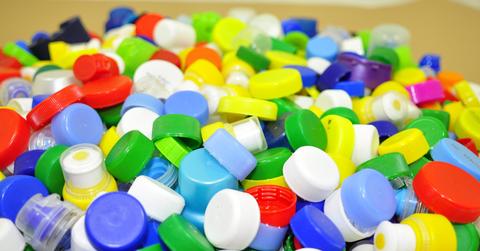The Four Steps Anyone Can Take To Keep Recyclables Away From Landfills
Of the items Americans throw away, half could be recycled. To reduce your carbon footprint, we need to reuse and reduce what we have. But for items you do throw out, here's how to make sure recyclable items stay far away from landfills.
Updated Nov. 19 2020, 9:38 p.m. ET
Of the items Americans throw away, half could be recycled—but isn’t. Luckily, this is something we can absolutely change.
The first step to reducing your carbon footprint is to simply reuse what you have, and to use less. It’s not sustainable for us to continuously buy disposable items and then toss them into the recycle bins. Especially when you consider that tin, aluminum, steel and glass are the only materials that can be recycled over and over indefinitely. Plastic’s fibers no longer hold together after around seven recycles, paper after four. Keep that in mind every time you get a paper bank statement, junk mail you have yet to unsubscribe from, or take a paper receipt.
To make sure the items you do use are recycled properly, you’ve got to make sure they find their way into the right bin. Ecofriend made things simple and outlined a four-step system to making sure everything that can be recycled, is.
Create recycling stations at home, work, and school. 
It’s easy to recycle when sorting stations are right in front of you. In recent years, airports, city centers, and fast food joints have done a much better job of streamlining their waste-collection processes so your soda can and disposable fork don’t end up with your plastic bag.
If you notice a lack of these sorting stations at your office, kid’s school, or at a local restaurant, ask. Write letters. Attend meetings. This is a really easy way to make a big difference.
Find out where your closest recycling center is.
If you have garbage pickup where you live, put the effort in to find out where the local transfer or recycling station is. These places will accept any number of recyclable products that aren’t as easy to sort, such as furniture, appliances, and old electronics. There are also businesses that will accept recyclable items. Thrift shops love plastic bag donations, and cell phone stores are usually happy to recycle your old phone for you.
Keep hazardous items out of the trash.
Batteries, old paint, adhesives and certain cleaning products should never be tossed in your regular garbage. These items need to be brought to hazardous waste collection sites, where workers treat certain things with chemical compounds to create a neutral reaction that won’t poison the ground when the product is thrown away.
A simple Google search can fill you in on the next hazardous materials location schedule for your neighborhood.
Share your recycling knowledge with the people around you.
When you learn something, share it. This is good advice for most serviceable information, and recycling isn’t an exception. The more information we all have about the waste stream (and more specifically, keeping things out of it), the more power we have to protect the resources we so vitally need.
